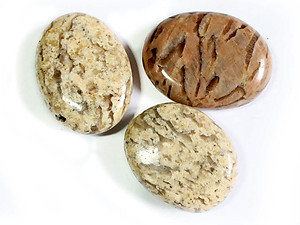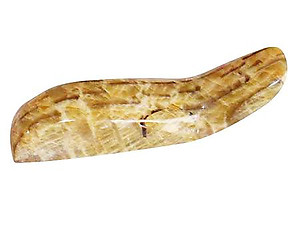Metaphysical guide of Zebradorite, Physical properties of Zebradorite
|
Rural miners in Madagascar came across this variety of Feldspar which they call (in French and Malagasy) "Feldspath". FELDSPAR, ORTHOCLASE Feldspars (KAlSi3O8 - NaAlSi3O8 - CaAl2Si2O8) are a group of rock-forming Tectosilicate minerals which
make up as much as 60% of the Earth's crust.
Feldspars crystallize from magma in both intrusive and extrusive igneous rocks as veins and are also present in many types of metamorphic rock. Rock formed almost entirely of Calcic Plagioclase Feldspar (see below)
is known as Anorthosite. Feldspars are also found in many types of sedimentary rock.
Feldspar is derived from the German word, "field" and the word "spath" meaning a rock that does not contain ore. "Feldspathic" refers to materials that contain feldspar. The alternate spelling, felspar, has now
largely fallen out of use.
This group of minerals consists of framework or Tectosilicates. Compositions of major elements in common Feldspars
can be expressed in terms of three end members:
Potassium-Feldspar (K-spar) endmember KAlSi3O8
Albite endmember NaAlSi3O8
Anorthite endmember CaAl2Si2O8
Solid solutions between K-feldspar and albite are called alkali feldspar. Solid solutions between albite and anorthite are called plagioclase,[1] or more properly plagioclase feldspar. Only limited solid solution occurs between K-feldspar and anorthite, and in the two other solid solutions, immiscibility occurs at temperatures common in the crust of the earth. Albite is considered both plagioclase and alkali feldspar. In addition to albite, barium feldspars are also considered both alkali and plagioclase feldspars. Barium feldspars form as the result of the replacement of potassium feldspar.
Physical properties of Zebradorite (Feldspar, Orthoclase): Category tectosilicate Chemical formula KAlSi3O8 - NaAlSi3O8 - CaAl2Si2O8 Identification Color: Shades of red to pink, white, gray, brown, colorless, greenish, yellow to grayish yellow, off white, shades of orange Crystal system triclinic or monoclinic Twinning tartan, carlsbad, etc Cleavage two or three Fracture along cleavage planes Mohs scale hardness 6 Luster vitreous Diaphaneity opaque Birefringence first order Pleochroism none Other characteristics exsolution lamellae common Location: Worldwide including Austria, Madagascar, UK, USA
Rarity: Common Fun Fact: Orthoclase is commonly used in the porcelain industry Stone Type/Family: Member of the Feldspar family, Silicate Class Crystal System: Monoclinic Chemical Composition: K(AlSi3O8) Potassium Aluminum Silicate Hardness: 6 Metaphysical Guide of Zebradorite (Feldspar, Orthoclase): Primary Chakra: ALL Astrological sign(s): Aquarius, Cancer Vibration: Number 9 (Feldspar) and Master Number 44 (Orthoclase) Metaphysically, Orthoclase Feldspar has a pleasant, refined energy. Orthoclase Feldspar can help overcome tragedy, as well as aligning the chakras and meridians of the physical body. Once you have attuned to this crystal, Orthoclase Feldspar can bring great peace during times of physical or emotional trauma. Known as the "stone of cooperative effort", Orthoclase Feldspar encourages cooperation among individuals and offers insight into group experiences. Orthoclase Feldspar can help one find new and unconventional ways to obtain goals, and is said to foster connection to the wisdom of ancient Egypt. Those lacking in self-confidence who carry low self-esteem can benefit from Orthoclase Feldspar's work with the Solar-Plexus Chakra, enhancing self-will and emotional strength and courage. Back to Metaphysical and Physical Guide Sources: Healingcrystals.com - Wikipedia.org |
The Zebradorite products that may help you



